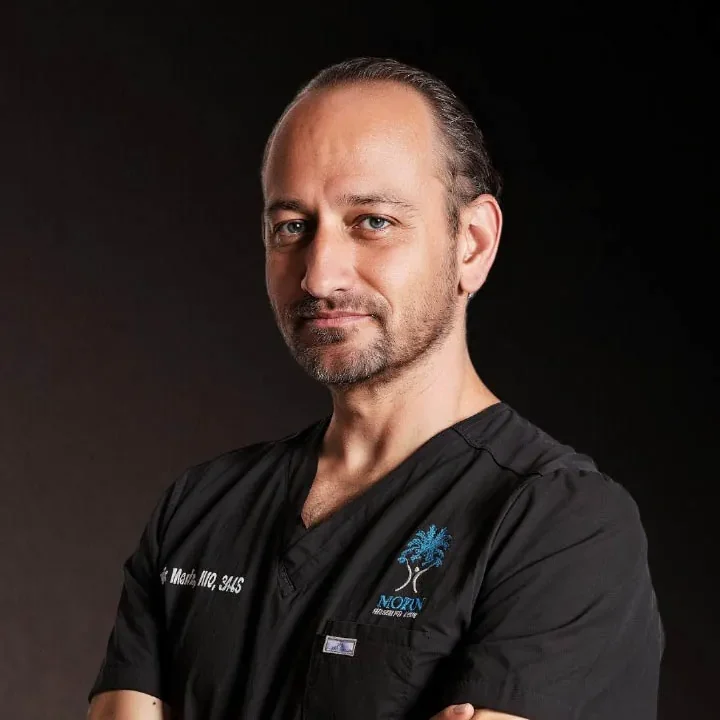Table of Contents
- Facts About Gynecomastia
- 1. Gynecomastia is Most Common in Puberty and Older Men
- 2. The Tissue Growth is Comprised of More Than Fat
- 3. Pseudogynecomastia Looks and Feels Like Gynecomastia
- 4. Gynecomastia is Primarily a Hormonal Condition
- 5. You Might Not Recognize Male Gyno Right Away
- 6. Something You Are Taking Could Be Causing Male Breast Growth
- 7. Gynecomastia Could Go Away On its Own
- 8. Male Gyno Surgery is the Best Permanent Treatment
- 9. Only a Trained Professional Can Perform Gynecomastia Surgery
- 10. Dr. Babak Moeinolmolki Can Give You a Firmer, More Masculine Chest
Facts About Gynecomastia
Gynecomastia is a condition that causes male chest tissue to expand beyond normal levels so it is important to know more on Gynecomastia facts that will introduce you about it. The condition can affect a male at any age, from infancy to old age.
Those are two Gynecomastia facts about this common condition that is said to affect nearly half of all men.
To be well-versed on the condition, it helps to remember these ten remaining Gynecomastia facts. You’ll soon learn that you are not alone in suffering from this condition. You will realize the effects male gyno has on the body and the ways it can be treated.
If at any time you wish to discuss treatment for excessive male breast growth, contact the Gynecomastia Center of Los Angeles to schedule a gynecomastia consultation.
1. Gynecomastia is Most Common in Puberty and Older Men
It’s said that up to 70% of boys in early to mid-puberty experience excessive male breast growth due to hormonal changes.
In most cases, this gynecomastia in teens will resolve on its own. That means treatment is not usually needed.
Some boys develop gynecomastia in overweight men where severe tenderness is present. The boy may also experience embarrassment at his condition, leading to psychological distress.
For these unfortunate boys, a short course of medication can sometimes help. Tamoxifen goes by the brand name Nolvadex and raloxifene goes by the brand Evista. These drugs block estrogen spikes in the body, which can reduce the size of male breasts.
Some doctors may not wish to prescribe these drugs since they are not approved by the US Food and Drug Administration, even though risks and benefits have been studied extensively.
Up to 65% of older men are affected by gynecomastia as well. For middle-aged and older men taking drugs that contribute to male breast growth, treatment is not usually recommended. Likewise for any man suffering from an underlying health condition. For these men, stopping the medications or treating the underlying condition usually allows the male breast tissue growth to resolve.
Prostate cancer patients tend to be older men. As it happens, gynecomastia is a common complication of prostate cancer treatment. Cancer treatments sometimes involve what is called androgen deprivation therapy or antiandrogen monotherapy, and these can exacerbate chest tissue growth in males. Drugs and radiation treatments can usually help to resolve the gynecomastia in older men.
2. The Tissue Growth is Comprised of More Than Fat
Most people would tell you that male breast growth is mostly made of fat. That, however, is a myth.
The truth of the matter is that gynecomastia is a glandular issue.
Sure, there is fat involved, and gynecomastia is most often seen in overweight men. However, fat alone is not the cause of the excess growth. Gynecomastia is the development of breast tissue in the chest area, which may be mixed with fat as well.
With glandular tissue being the primary factor behind male breast tissue growth, gynecomastia surgery is the most recommended treatment available.
3. Pseudogynecomastia Looks and Feels Like Gynecomastia
Conduct a self-breast exam. When pressing around your areola, feel around for a mushy pad of tissue. That is breast or glandular tissue. If you don’t feel this firm but malleable disc, you may have what is called false gyno or pseudo gynecomastia.
With pseudo gyno, the chest is carrying an abnormal amount of fat. This can create the impression of female-like breasts. Diet and exercise can sometimes help the condition resolve. Liposuction can treat pseudo gyno cases that don’t resort to traditional means of losing fat.

4. Gynecomastia is Primarily a Hormonal Condition
A major culprit behind gynecomastia is a hormonal imbalance. Testosterone is the male hormone that contributes to a lower voice and greater muscle growth in pubescent boys. Teenage girls develop breasts and curvier figures due to estrogen. In some pubescent boys, estrogen overtakes testosterone, leading to the growth of female-like breasts.
Hormonal imbalances don’t just occur at puberty. Men begin to experience a decline in testosterone later in life. If the man is also overweight, hormonal imbalances are likely, which can lead to male breasts and other health issues.
5. You Might Not Recognize Male Gyno Right Away
Excess tissue growth may begin as a tiny lump underneath the nipple. This might happen in one or both breasts. Pressing on the tissue might bring about a tenderness that wasn’t there before.
Other symptoms of gynecomastia can mimic separate medical conditions.
For example, if you only have swelling on one side of your chest and discharge coming from your nipple, you should get checked for male breast cancer. You should then watch out for asymmetrical gynecomastia, which is a benign condition that can mimic male breast cancer.
Only an official gynecomastia diagnosis by a gynecomastia surgeon or doctor can determine if you suffer from gynecomastia. You should speak with your doctor if you notice anything out of the ordinary about your body and/or chest.
6. Something You Are Taking Could Be Causing Male Breast Growth
Gynecomastia can be caused by a myriad of things, including genetics and an unhealthy lifestyle. However, in some cases, male breast growth can be caused by something you are ingesting or are otherwise exposed to.
For example, many don’t know that excessive male breast growth is linked to alcohol usage. If you drink excessively, you might try cutting back to see if the tissue growth subsides.
In addition to alcohol, some medications can contribute to breast tissue growth, including those for the prostate, antidepressants, antibiotics, and heart conditions.
A drug called Risperdal has been linked to male breast tissue growth in adolescent boys. The condition not only involves tissue growth but also the secretion of milk. The drug’s intended use is to treat mental health conditions like schizophrenia, bipolar disorders, and autism.
The misuse of steroids is another common culprit of male gynecomastia. When you flood your body with testosterone and then come off steroids, your body may produce more estrogen to compensate for the higher test levels. This can exacerbate the gynecomastia condition.
7. Gynecomastia Could Go Away On its Own

8. Male Gyno Surgery is the Best Permanent Treatment
In situations where the hormones don’t correct themselves or lifestyle changes don’t work to reverse gynecomastia, surgery is the best option.
Gynecomastia surgery is the permanent solution to enlarged male breasts.
The procedure can be customized to your exact needs. It all depends on the type of gyno you happen to be suffering from. The type is determined by the severity of the condition and the amount of tissue that needs to be removed.
Male breast growth ranges from minor, where there is only a slight bulge to the chest, to severe, which can mimic female breasts.
Male breast reduction surgery, otherwise known as gynecomastia surgery, involves the removal of tissue and fat with time-tested techniques.
If excessive skin is present, male breast reduction surgery involves the excision or cutting away of that tissue. The extra skin is removed and the chest recontoured to give it a masculine shape.
If excess fat is present, a popular cosmetic surgery technique called liposuction comes into play. Liposuction involves the suction of fat from underneath the chest area. A metal tube called a cannula gets inserted into small incisions along the chest.
The cannula is used to break up the fat from the connective tissue surrounding it, allowing for easier removal. The fat is broken up with a special solution that also numbs the area. The entire surgery takes an hour or a few hours, depending on the severity of the gynecomastia, and most patients return home the same day.
Recovery after surgery is a breeze. You will want to take it easy for a few days. You may have drainage tubes placed at the treatment area to control fluids. Those are then removed in a follow-up visit with your surgeon in a week or two.
A compression vest gets worn for up to three weeks. This heavy garment may be awkward at first, but you will soon get used to it. You should wear the garment as much as you can throughout the day, only removing it to bathe and tend to the treatment site.
You will be in charge of changing your own bandages. Your gynecomastia surgeon will inform you of the proper procedure.
Once the compression vest comes off, there may still be swelling around the affected area. That swelling and any bruising that is present will usually subside in three to four weeks.
In about six weeks, you should be back to your regular routine.
Gynecomastia is unlikely to return after gyno surgery unless you continue to use the offending culprits we mentioned earlier.

9. Only a Trained Professional Can Perform Gynecomastia Surgery
Since gynecomastia is treatable, there’s a myth that any surgeon who know about Gynecomastia facts can perform the procedure. It is imperative that you conduct adequate research before choosing a surgeon for male breast reduction and that he can satisfactorily explain those Gynecomastia facts.
The ideal gyno surgeon has medical training from top institutions, know deeply about Gynecomastia facts, a proven record performing gynecomastia on patients like yourself, and is easily accessible based on where you live (or where you can travel to).
10. Dr. Babak Moeinolmolki Can Give You a Firmer, More Masculine Chest
Dr. Moein has decades of medical training and fellowship training from top educational institutions and hospitals around the country that is why he is adept in Gynecomastia facts. A Los Angeles native, Dr. Moein frequently volunteers his surgical skills, which has him performing procedures like gynecomastia surgery to patients all over the world. Dr. Moein is known for his compassionate and knowledgeable bedside manner and has a proven record as one of the best gynecomastia surgeons in Southern California.
Want to discuss surgery and what it can do for you? Whether you have a minor form of the condition, or your male breast tissue is excessively severe, male breast reduction surgery could help you.
At the Gynecomastia Center of Los Angeles, we understand the psychological trauma that can come from having breasts as a man. Dr. Moein and his attentive staff help you feel comfortable as you seek treatment for this common problem.
Once a diagnosis is made, which only comes after blood and other tests, and sometimes using imaging technology, surgery may be recommended.
Male breast reduction surgery flattens your chest. The procedure removes the excess tissue to leave your chest firmer and masculine. Bodybuilders with gynecomastia will see more of their hard work showing through the skin, without fat or glandular tissue getting in the way.
Now that you know these Gynecomastia facts, start envisioning how your re-contoured chest might look before calling the Gynecomastia Center of Los Angeles. You can schedule a consultation with Dr. Moein for male breast reduction surgery or learn more about Gynecomastia facts by calling us from anywhere throughout Los Angeles, Encino, or Glendale, California.
Travel surgery is also available for those living out of Los Angeles but wished to know more about Gynecomastia facts.

Dr.Babak Moeinolmolki
LA Cosmetic Surgeon Dr. Moein is board-certified by the American Board of General Surgery.

